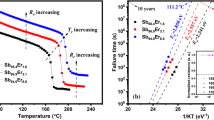Abstract
The structural transformation and transformation kinetics of Sb x Se100−x films (60 ≤ x ≤ 70) were studied to investigate the feasibility of applying Sb x Se100−x alloys in phase-change nonvolatile memories. The temperature-dependent van der Pauw measurements, Hall measurements, X-ray diffraction and a static tester were used to investigate the electrical properties and crystallization behavior of the Sb x Se100−x films. The sheet resistance difference between amorphous and crystalline state was higher than 104 Ω per square According to Hall measurement, Sb x Se100−x films have p-type conduction and the Hall mobility and carrier concentration increases with the increase in Sb content. The crystalline structure of the metastable phase of Sb x Se100−x alloys, which plays a major roll in fast crystallization, is similar to that of Sb2Te (rhombohedral structure). The transition temperature, sheet resistance and activation energy for transformation decrease as the amount of Sb increases in the Sb x Se100−x film. Applying the Kissinger method, the activation energies for crystallization were in the range from 1.90 ± 0.15 to 4.16 ± 0.28 eV. The desired crystallization speed can be obtained by a systematic change of the composition owing to the variation of the activation barrier with stoichiometry.






Similar content being viewed by others
Explore related subjects
Discover the latest articles and news from researchers in related subjects, suggested using machine learning.References
Babeva Tz, Dimitrov D, Kitova S, Konstantinov I (2000) Optical properties of phase-change optical disks with Sb x Se100−x films. Vacuum 58:496–501
Barton R, Davis CR, Rubin K, Lim G (1986) New phase change materials for optical recording with short erase time. Appl Phys Lett 48:1255–1257
Dimitrov D, Ollacarizqueta MA, Afonso CN, Starbov N (1996) Crystallization kinetics of Sb x Se100−x thin films. Thin Solid Films 280:278–283
El-Wahabb EA, Fouad SS, Fadel M (2003) Theoretical and experimental study of the conduction mechanism in Sb2Se3 alloy. J Mater Sci 38:527–532
Fouad SS, Ammar AH, Abo-Ghajala M (1997) The relationship between optical gap and chemical composition in Sb x Se1−x system. Physica B 229:249–255
Fujimori S, Yagi S, Yamazaki H, Funakoshi N (1988) Crystallization process of Sb–Te alloy films for optical storage. J Appl Phys 64:1000–1004
Ghosh G (1993) Sb–Se (Antimony–Selenium). J Phase Equilib 14
Ha YH, Yi JH, Horii H, Park JH, Joo SH, Park SO, Chung UI, Moon JT (2003) An edge contact type cell for phase change RAM featuring very low power consumption. Symposium VLSI Tech Dig:175–176
Horii H, Yi JH, Park JH, Ha YH, Baek IG; Park SO, Hwang YN, Lee SH, Kim YT, Lee KH, Chung UI, Moon JT (2003) A novel cell technology using N-doped GeSbTe films for phase change RAM. Symposium VLSI Tech Dig:177–178
Hosaka S, Miyauchi K, Tamura T, Sone H, Koyanagi H (2004) Proposal for a memory transistor using phase-change and nanosize effects. Microelectron Eng 73–74:736–740
Imamov PM, Semiletov SA (1971) Sov Phys Crystallogr 15:845–850
Kim JH (1999) Correlation between microstructure and optical properties of Ge2Sb2Te5 thin films. J Appl Phys 86:6770–6772
Lai S (2003) Current status of the phase change memory and its future. IEDM Tech Dig:255–258
Lai S, Lowrey T (2001) OUM—A 180 nm nonvolatile memory cell element technology for stand alone and embedded applications. IEMD Tech Dig:803–806
Maimon JD, Spall E, Quinn R, Schnur S (2001) Chalcogenide-based non-volatile memory technology. In: Proceedings IEEE aerospace conference:2289–2294
Maimon JD, Hunt KK, Burcin L, Rodgers J (2003) Chalcogenide memory arrays: characterization and radiation effects. IEEE Trans Nucl Sci 50:1878–1884
Ohshima N (1996) Crystallization of germanium–antimony–tellurium amorphous thin film sandwiched between various dielectric protective films. J Appl Phys 79:8357–8363
Park J, Kim MR, Choi WS, Seo H, Yeon C (1999) Characterization of amorphous phases of Ge2Sb2Te5 phase-change optical recording material on their crystallization behavior. Jpn J Appl Phys 38:4775–4779
Tominaga J, Nakano T, Atoda N (1998) Double optical phase transition of GeSbTe thin films sandwiched between two SiN layers. Jpn J Appl Phys 37:1852–1854
Weidenhof V, Friedrich I, Ziegler S, Wuttig M (1999) Atomic force microscopy study of laser induced phase transitions in Ge2Sb2Te5. J Appl Phys 86:5879–5887
Weidenhof V, Pirch N, Friedrich I, Ziegler S, Wuttig M (2000) Minimum time for laser induced amorphization of Ge2Sb2Te5 films. J Appl Phys 88:657–664
Wöltgens HW (2003) Combinatorial material synthesis applied to Ge–b–Te based phase-change materials. PhD thesis, RWTH Aachen Germany
Yamada N, Ohno E, Nishiuchi K, Akahira N, Takao M (1991) Rapid phase transitions of GeTe–Sb2Te3 pseudobinary amorphous thin films for optical disk memory. J Appl Phys 69:2849–2856
Acknowledgments
The one of the authors, M. J. Kang, would like to thank the Korea Science and Engineering Foundation (KOSEF) for a fellowship to carry out this research work at the I. Physikalisches Institut der RWTH Aachen, Germany.
Author information
Authors and Affiliations
Corresponding author
Rights and permissions
About this article
Cite this article
Kang, M.J., Park, T.J., Wamwangi, D. et al. Electrical properties and crystallization behavior of Sb x Se100−x thin films. Microsyst Technol 13, 153–159 (2007). https://doi.org/10.1007/s00542-006-0154-7
Received:
Accepted:
Published:
Issue Date:
DOI: https://doi.org/10.1007/s00542-006-0154-7




